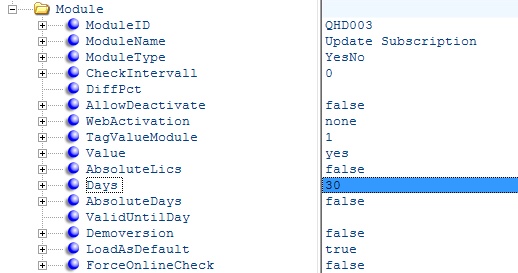
Licence Protector 5
Maintenance contracts
There are 2 ways to handle maintenance contracts
•Make regular online checks, e.g. every 30 days
•Send out an activation key to renew the contract
Pros/Cons
Regular online checks
+The regular online checks is convenient for the customer as he does not have to type in a key
- The software vendor has to manually lock the license
- An online connection is necessary
Using activation keys
+ Completely automated for the software vendor
+ Online connection not required
- Customer has to type in a key
- Needs an e-commerce integration for automation
Using an Activation Key to handle a maintenance contract
You can easily implement, whether your customer may install an update or not. Add a new module of the type Yes/No (module type 4) with the module name Update Subscription. Set a default value for number of days - e.g. 30 days.
Tests within the application
The expiry date is calculated, when you use the ValidatesYes command. During evaluation time of the software, don't test the update subscription module. When the version is a full version (Status of Activation is set to done - GetWebActivation) use ValidatesYes to start the subscription.
Tests within the update program
Your update program now checks, if the module is available and if it has expired. If the module is available and not expired, the update can be installed. Otherwise you display an error message like: Update Subscription has expired and the update cannot install.
The commands are:
•ValidatesYes - to check if the module is set to Yes or No
•RemainingDays - to check if the module is time limited or not
If your customer buys an update subscription, you just send him an Activation Key for the desired time period.
This is a very convenient way to handle updates, because you can place the update on the internet and only customers with a valid update subscription can install it.
You can automate billing in combination with e-commerce providers . They offer to create recurring invoices, e.g. every 3, 6 or 12 month. If the customer pays the invoice, then an Activation Key for the module is generated to prolong the period for 3, 6 or 12 month. See Integration in Online Shops.

 Combine this test with a Release Number. You could then install a service pack for a specific release without having a valid update subscription.
Combine this test with a Release Number. You could then install a service pack for a specific release without having a valid update subscription.
